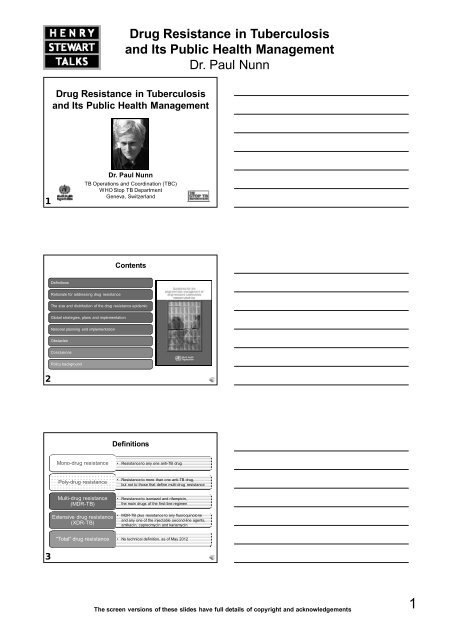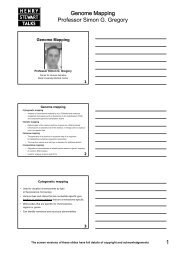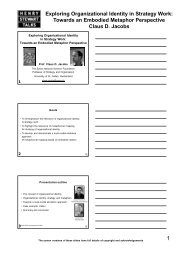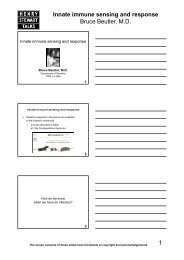Drug Resistance in Tuberculosis and Its Public Health Management ...
Drug Resistance in Tuberculosis and Its Public Health Management ...
Drug Resistance in Tuberculosis and Its Public Health Management ...
- No tags were found...
You also want an ePaper? Increase the reach of your titles
YUMPU automatically turns print PDFs into web optimized ePapers that Google loves.
<strong>Drug</strong> <strong>Resistance</strong> <strong>in</strong> <strong>Tuberculosis</strong><strong>and</strong> <strong>Its</strong> <strong>Public</strong> <strong>Health</strong> <strong>Management</strong>Dr. Paul Nunn<strong>Drug</strong> <strong>Resistance</strong> <strong>in</strong> <strong>Tuberculosis</strong><strong>and</strong> <strong>Its</strong> <strong>Public</strong> <strong>Health</strong> <strong>Management</strong>1Dr. Paul NunnTB Operations <strong>and</strong> Coord<strong>in</strong>ation (TBC)WHO Stop TB DepartmentGeneva, Switzerl<strong>and</strong>ContentsDef<strong>in</strong>itionsRationale for address<strong>in</strong>g drug resistanceThe size <strong>and</strong> distribution of the drug resistance epidemicGlobal strategies, plans <strong>and</strong> implementationNational plann<strong>in</strong>g <strong>and</strong> implementationObstaclesConclusionsPolicy background2Def<strong>in</strong>itionsMono-drug resistance• <strong>Resistance</strong> to any one anti-TB drugPoly-drug resistance• <strong>Resistance</strong> to more than one anti-TB drug,but not to those that def<strong>in</strong>e multi-drug resistanceMulti-drug resistance(MDR-TB)Extensive drug resistance(XDR-TB)• <strong>Resistance</strong> to isoniazid <strong>and</strong> rifampic<strong>in</strong>,the ma<strong>in</strong> drugs of the first-l<strong>in</strong>e regimen• MDR-TB plus resistance to any fluoroqu<strong>in</strong>olone<strong>and</strong> any one of the <strong>in</strong>jectable second-l<strong>in</strong>e agents,amikac<strong>in</strong>, capreomyc<strong>in</strong> <strong>and</strong> kanamyc<strong>in</strong>"Total" drug resistance• No technical def<strong>in</strong>ition, as of May 20123The screen versions of these slides have full details of copyright <strong>and</strong> acknowledgements1
4<strong>Drug</strong> <strong>Resistance</strong> <strong>in</strong> <strong>Tuberculosis</strong><strong>and</strong> <strong>Its</strong> <strong>Public</strong> <strong>Health</strong> <strong>Management</strong>Dr. Paul NunnRationale for concern about MDR-TB,<strong>and</strong> worse forms of resistanceMDR-TB is:• Much more difficult <strong>and</strong> expensive to treat than susceptible TB• Represents "catastrophic expenditure" for any family affected• Highly lethal <strong>in</strong> HIV populations (80-98% case fatality reported)• Countries generally have very low capacity to respond• MDR stra<strong>in</strong>s already replac<strong>in</strong>g susceptible ones –especially <strong>in</strong> Eastern Europe• 3.6% of all TB, but ris<strong>in</strong>g <strong>in</strong> many countries• M<strong>in</strong>sk, Belarus – 35% <strong>in</strong> new patients, 76% <strong>in</strong> previously treated*• Yet, political will is difficult to generate*Skrah<strong>in</strong>a A et al., Europ Resp J. 2012, 39(6): 1425-1431As drug resistance <strong>in</strong>creases,treatment success rates fall –<strong>and</strong> mortality <strong>in</strong>creases2.6 million smear +ve cases –2009 cohort<strong>Drug</strong> susceptible TBTreatment success 87%, Mortality 4%2008 cohorts816 – 4,383 casesMDR-TBTreatment success 22 – 74%Mortality 5 - 20%52008 cohorts19 – 345 casesData from WHO; Global <strong>Tuberculosis</strong> Control 2011XDR-TBTreatment success 5 - 44%Mortality 21 - 90%Manag<strong>in</strong>g a severe epidemic of resistance6The screen versions of these slides have full details of copyright <strong>and</strong> acknowledgements2
<strong>Drug</strong> <strong>Resistance</strong> <strong>in</strong> <strong>Tuberculosis</strong><strong>and</strong> <strong>Its</strong> <strong>Public</strong> <strong>Health</strong> <strong>Management</strong>Dr. Paul NunnDistribution of proportion of MDRamong previously treated TB cases, 1994-2010• The boundaries <strong>and</strong> names shown <strong>and</strong> the designations used on this map do not imply the expression of any op<strong>in</strong>ion whatsoeveron the part of the World <strong>Health</strong> Organization concern<strong>in</strong>g the legal status of any country, territory, city or area or of its authorities,or concern<strong>in</strong>g the delimitation of its frontiers or boundaries10• Dotted l<strong>in</strong>es on maps represent approximate border l<strong>in</strong>es for which there may not yet be full agreement. © WHO 2011. All rights reservedEstimated MDR-TB <strong>in</strong>cidence rates, 2009(new <strong>and</strong> previously treated)Selected countriesof the former Soviet Union:Estonia: 7 / 100,000Kazakhstan: 57 / 100,000Russia: 27 / 100,000Tajikistan: 59 / 100,000African countries with estimatedMDR-TB <strong>in</strong>cidence rates ≥ 15;MDR-TB cases per 100,000population:Botswana: 27 / 100,000Mozambique: 16 / 100,000Namibia: 17 / 100,000Rw<strong>and</strong>a: 16 / 100,000South Africa: 26 / 100,000Swazil<strong>and</strong>: 23 / 100,000Zimbabwe: 19 / 100,00011India: 8 / 100,000Ch<strong>in</strong>a: 7 / 100,000MDR-TBcasesemerg<strong>in</strong>gannually,per 100,000population13 top sett<strong>in</strong>gs with highest % of MDR-TBamong new cases, 2001-2010M<strong>in</strong>sk, Belarus (2010)35.312The screen versions of these slides have full details of copyright <strong>and</strong> acknowledgements4
<strong>Drug</strong> <strong>Resistance</strong> <strong>in</strong> <strong>Tuberculosis</strong><strong>and</strong> <strong>Its</strong> <strong>Public</strong> <strong>Health</strong> <strong>Management</strong>Dr. Paul NunnTime trends <strong>in</strong> TB (<strong>in</strong>cidence/100,000 population, log scale)<strong>and</strong> MDR-TB (proportion of all TB)1000100____ TB____ MDR -TB0.3% per yearBotswana1019.4% per year11996 1998 2000 2002 2004 2006 2008100Tomsk Oblast, Russia____ TB ____ MDR-TB2.4% per year____ TB ____ MDR-TB10100-6.7% per yearEstonia1-2.4% per year101999 2001 2003 2005 2007 2009113-5.1% per year1998 2000 2002 2004 2006 2008Countries that had reportedat least one XDR-TB case by end March 2011% XDR <strong>in</strong> MDR 9.4%(95% CI: 7.4-11.6)Argent<strong>in</strong>a Bhutan France Japan Namibia Republic of Korea Thail<strong>and</strong>Armenia Cambodia Georgia Kazakhstan Nepal Republic of Moldova TogoAustralia Canada Germany Kenya Netherl<strong>and</strong>s Romania TunisiaAustria Chile Greece Kyrgyzstan Norway Russian Federation Ukra<strong>in</strong>eAzerbaijan Ch<strong>in</strong>a India Latvia Pakistan Slovenia United Arab EmiratesBangladesh Colombia Indonesia Lesotho Peru South Africa United K<strong>in</strong>gdomBelgium Czech Republic Iran (Islamic Lithuania Philipp<strong>in</strong>es Spa<strong>in</strong> United States of AmericaRep. of)Botswana Ecuador Irel<strong>and</strong> Mexico Pol<strong>and</strong> Swazil<strong>and</strong> UzbekistanBrazil Egypt Israel Mozambique Portugal Sweden Viet NamBurk<strong>in</strong>a Faso Estonia Italy Myanmar Qatar TajikistanThe boundaries <strong>and</strong> names shown <strong>and</strong> the designations used on this map do not imply the expression of any op<strong>in</strong>ion whatsoever on thepart of the World <strong>Health</strong> Organization concern<strong>in</strong>g the legal status of any country, territory, city or area or of its authorities, or concern<strong>in</strong>gthe delimitation of its frontiers or boundaries; Dotted l<strong>in</strong>es on maps represent approximate border l<strong>in</strong>es for whichthere may not yet be full agreement.; © WHO 2011. All rights reserved14Global strategies, plans <strong>and</strong> implementation15The screen versions of these slides have full details of copyright <strong>and</strong> acknowledgements5
<strong>Drug</strong> <strong>Resistance</strong> <strong>in</strong> <strong>Tuberculosis</strong><strong>and</strong> <strong>Its</strong> <strong>Public</strong> <strong>Health</strong> <strong>Management</strong>Dr. Paul NunnStrategic challenges<strong>in</strong> the control of MDR <strong>and</strong> XDR-TB16• Political/Fund<strong>in</strong>g• F<strong>in</strong>ancial barriers to patients• Engag<strong>in</strong>g all care providers• Optimiz<strong>in</strong>g management <strong>and</strong> care• Address<strong>in</strong>g laboratory crisis• Ensur<strong>in</strong>g access to quality-assured drugs• Controll<strong>in</strong>g availability of anti-TB drugs• Prioritiz<strong>in</strong>g <strong>in</strong>fection control• Address<strong>in</strong>g health workforce crisis• Improv<strong>in</strong>g surveillance systems• Invest<strong>in</strong>g <strong>in</strong> research <strong>and</strong> developmentIndicators for PMDTIndicators 2009 Basel<strong>in</strong>e 2015 Target% previously treated cases tested for MDR-TB 7% 100%% new bact. +ve cases tested for MDR-TB 7% 20%No. countries with >1 C lab per 5m population 18 36% confirmed cases of MDR-TB enrolled on Rxby WHO st<strong>and</strong>ards36% 100%No. confirmed cases of MDR-TB enrolled on Rxby WHO st<strong>and</strong>ards11,000 270,000Treatment success rate among MDR-TB cases 60% >75%17Fund<strong>in</strong>g <strong>in</strong>creas<strong>in</strong>g,but lower than set out <strong>in</strong> global plan18 Source: WHO Global <strong>Tuberculosis</strong> Control Report 2011The screen versions of these slides have full details of copyright <strong>and</strong> acknowledgements6
<strong>Drug</strong> <strong>Resistance</strong> <strong>in</strong> <strong>Tuberculosis</strong><strong>and</strong> <strong>Its</strong> <strong>Public</strong> <strong>Health</strong> <strong>Management</strong>Dr. Paul NunnMDR-TB cases notified,projected <strong>and</strong> global targets –report<strong>in</strong>g improv<strong>in</strong>g, but notificationstill far from targetNumber of patients (thous<strong>and</strong>s)Projected enrolmentsGlobal plan targetsNon-GLCGLC19 Source: WHO Global <strong>Tuberculosis</strong> Control Report 2011120001000080006000MDR-TB treatment enrolment targets 2011<strong>in</strong> 27 HBC• GPSTB target for 27 HBC = 112,000• 27 HBC plan target = 44,200• Projected enrolment <strong>in</strong> 27 HBC pre 2011 = 30,000• Estimated global enrolment = 18,00040002000020DST coverage <strong>in</strong> 2010: diagnostic capacity<strong>and</strong>/or data transmission issues?21GPSTB 2015 targets: 20% of new & 100% of retreatment cases to have DSTThe screen versions of these slides have full details of copyright <strong>and</strong> acknowledgements7
<strong>Drug</strong> <strong>Resistance</strong> <strong>in</strong> <strong>Tuberculosis</strong><strong>and</strong> <strong>Its</strong> <strong>Public</strong> <strong>Health</strong> <strong>Management</strong>Dr. Paul NunnMore countries report<strong>in</strong>g outcomesof patients on second-l<strong>in</strong>e treatment, but…% success was only 53% for patients startedon treatment <strong>in</strong> 2008 (2015 target is 75% or more)22Source: WHO Global <strong>Tuberculosis</strong> Control Report 2011National level plann<strong>in</strong>g <strong>and</strong> implementation23Guidance for country level plann<strong>in</strong>g for MDR-TBmanagement programmes24The screen versions of these slides have full details of copyright <strong>and</strong> acknowledgements8
<strong>Drug</strong> <strong>Resistance</strong> <strong>in</strong> <strong>Tuberculosis</strong><strong>and</strong> <strong>Its</strong> <strong>Public</strong> <strong>Health</strong> <strong>Management</strong>Dr. Paul NunnWhy is plann<strong>in</strong>g for MDR-TBtreatment programmes important?• MDR-TB treatment is difficult, complex, time-consum<strong>in</strong>g<strong>and</strong> expensive – much more so than drug sensitive TB• Provision of reliable treatment to hundreds of patientsfor ~2 years on a national scale requires enormouscoord<strong>in</strong>ation of multiple players – <strong>and</strong> is thus a majorplann<strong>in</strong>g exercise25http://www.path.org/publications/detail.php?i=1678Essential pr<strong>in</strong>ciples of care for MDR-TBstrengthen basic TB controlPolitical commitment to implement objectives of the responsewith adequate budget to startMicrobiological diagnosis (culture, drug susceptibility test by a qualityassuredlaboratory) <strong>and</strong> monitor<strong>in</strong>g of response to treatmentCollaboration with HIV programmePatient-centred approach for direct observation of treatmenton out-patient or hospitalised basisCare under proper <strong>in</strong>fection control conditions26Quality assured second-l<strong>in</strong>e anti-TB drugs, meet<strong>in</strong>g at leastWHO-GMP st<strong>and</strong>ardsRecord<strong>in</strong>g <strong>and</strong> report<strong>in</strong>g for monitor<strong>in</strong>g <strong>and</strong> evaluationEssential elements <strong>in</strong> plann<strong>in</strong>g the strengthen<strong>in</strong>gof basic TB control through MDR-TB managementEstimate burdenMeasure diagnostic capacity <strong>in</strong> place <strong>and</strong> def<strong>in</strong>e gapsDecide models of care (hospitalisation, outpatient)Ensure <strong>in</strong>fection control measures <strong>in</strong> place <strong>and</strong> def<strong>in</strong>e gapsEnsure social support networkPlan drug procurement – second-l<strong>in</strong>e anti-TB drugs <strong>and</strong> those for adverse effectsSet up record<strong>in</strong>g <strong>and</strong> report<strong>in</strong>g systemEnsure workforce <strong>in</strong> place <strong>and</strong> def<strong>in</strong>e gapsSet up staff development <strong>and</strong> tra<strong>in</strong><strong>in</strong>gWrite national guidel<strong>in</strong>es <strong>and</strong> manual of operationsConsider operational research agendaBudget <strong>and</strong> f<strong>in</strong>anc<strong>in</strong>g27The screen versions of these slides have full details of copyright <strong>and</strong> acknowledgements9
28<strong>Drug</strong> <strong>Resistance</strong> <strong>in</strong> <strong>Tuberculosis</strong><strong>and</strong> <strong>Its</strong> <strong>Public</strong> <strong>Health</strong> <strong>Management</strong>Dr. Paul NunnSpecific recommendations from 2011Guidel<strong>in</strong>es for Programmatic <strong>Management</strong>of <strong>Drug</strong> Resistant TB (PMDT)• Rapid drug susceptibility test<strong>in</strong>g (DST)of isoniazid <strong>and</strong> rifampic<strong>in</strong> or of rifampic<strong>in</strong> aloneis suggested over conventional test<strong>in</strong>gor no test<strong>in</strong>g at the time of diagnosis of TB• The use of sputum smear microscopy <strong>and</strong> culturerather than sputum smear microscopy aloneis recommended for the monitor<strong>in</strong>g of patientswith MDR-TB dur<strong>in</strong>g treatment• In the treatment of patients with MDR-TB:– A later generation Fluoroqu<strong>in</strong>olone should be used– Ethionamide (or prothionamide) should be usedSpecific recommendations (2)• In the treatment of patients with MDR-TB it is advised thatfour second-l<strong>in</strong>e anti-tuberculosis drugs likely to be effective(<strong>in</strong>clud<strong>in</strong>g a parenteral agent), as well as pyraz<strong>in</strong>amide,should be <strong>in</strong>cluded <strong>in</strong> the <strong>in</strong>tensive phase• Regimens should also <strong>in</strong>clude either cycloser<strong>in</strong>e or PAS(p-am<strong>in</strong>osalicylic acid) if cycloser<strong>in</strong>e cannot be used29Specific recommendations (3)• In the treatment of patients with MDR-TB,an <strong>in</strong>tensive phase of 8 months’ duration is advised• A total treatment duration of at least 20 months<strong>in</strong> patients without any previous MDR-TB treatment30The screen versions of these slides have full details of copyright <strong>and</strong> acknowledgements10
<strong>Drug</strong> <strong>Resistance</strong> <strong>in</strong> <strong>Tuberculosis</strong><strong>and</strong> <strong>Its</strong> <strong>Public</strong> <strong>Health</strong> <strong>Management</strong>Dr. Paul NunnSpecific recommendations (4)• Antiretroviral therapy is advised for all patientswith HIV <strong>and</strong> drug-resistant TB requir<strong>in</strong>g second-l<strong>in</strong>eanti-tuberculosis drugs, irrespective of CD4 cell-count,as early as possible (with<strong>in</strong> the first 8 weeks)follow<strong>in</strong>g <strong>in</strong>itiation of anti-tuberculosis treatment• Patients with MDR-TB should be treatedus<strong>in</strong>g ma<strong>in</strong>ly ambulatory care rather thanmodels of care based pr<strong>in</strong>cipally on hospitalisation31Research gapsThe 2011 update revealed important gaps <strong>in</strong> knowledge, <strong>in</strong>clud<strong>in</strong>g:• A lack evidence from r<strong>and</strong>omized controlled trialsfor best treatment regimens <strong>and</strong> treatment duration• Lack of evidence for optimal drug regimens for treat<strong>in</strong>g patientswith isoniazid resistance, with XDR-TB <strong>and</strong> with non-MDR-TBpolydrug-resistance• Very limited <strong>in</strong>formation about:• Treatment of paediatric MDR-TB• Identification of the most effective chemoprophylaxisfor contacts of MDR-TB cases• Therapy for symptomatic relief from adverse reactions32Obstacles to MDR-TB management33The screen versions of these slides have full details of copyright <strong>and</strong> acknowledgements11
<strong>Drug</strong> <strong>Resistance</strong> <strong>in</strong> <strong>Tuberculosis</strong><strong>and</strong> <strong>Its</strong> <strong>Public</strong> <strong>Health</strong> <strong>Management</strong>Dr. Paul NunnWhy are so few cases of MDR-TBdiagnosed <strong>and</strong> treated?Insufficient national political commitment <strong>and</strong> ownership• National plans far below targets <strong>in</strong> Global Plan <strong>and</strong> WHA resolution 62.15Second-l<strong>in</strong>e drug costs rema<strong>in</strong> exorbitant, at around $3000 per course• Funds <strong>in</strong>creased from US$ 0.2b <strong>in</strong> 2006 to US$ 0.7b <strong>in</strong> 2011, but still US$ 0.2b short of needInsufficient l<strong>in</strong>ks between diagnosis <strong>and</strong> treatmentUncerta<strong>in</strong>ty around the future of the Global Fund,which has been vital to progress34Countries nevertheless are mov<strong>in</strong>g <strong>and</strong> better plann<strong>in</strong>g is needed35Conclusions1. <strong>Management</strong> of MDR-TB is <strong>in</strong> the <strong>in</strong>terestsof the public health – it saves lives2. Provision of care for people with MDR-TBis <strong>in</strong>sufficient <strong>and</strong> <strong>in</strong>creas<strong>in</strong>g too slowly3. Greater national-level political commitmentis the most urgent need4. Reduction <strong>in</strong> the costs of second-l<strong>in</strong>e drugsis the next most important5. Guidance is available from the global levelfor most aspects of MDR-TB management6. If you feel there are any gaps please contactWHO Stop TB Department - glc@who.<strong>in</strong>tPolicy background36The screen versions of these slides have full details of copyright <strong>and</strong> acknowledgements12
37<strong>Drug</strong> <strong>Resistance</strong> <strong>in</strong> <strong>Tuberculosis</strong><strong>and</strong> <strong>Its</strong> <strong>Public</strong> <strong>Health</strong> <strong>Management</strong>Dr. Paul Nunn• Plann<strong>in</strong>g:– MDR-TB plann<strong>in</strong>g toolkit (http://www.path.org/publications/detail.php?i=1678)– MDR/XDR-TB assessment <strong>and</strong> monitor<strong>in</strong>g tool (http://www.path.org/publications/detail.php?i=1678)– Plann<strong>in</strong>g <strong>and</strong> budget<strong>in</strong>g tool for TB control(http://www.who.<strong>in</strong>t/tb/publications/factsheet_pbtool_mar10.pdf)• Implement<strong>in</strong>g<strong>Management</strong> of MDR-TB diagnosis,treatment <strong>and</strong> care– PMDT Guidel<strong>in</strong>eshttp://www.who.<strong>in</strong>t/tb/challenges/mdr/programmatic_guidel<strong>in</strong>es_for_mdrtb/en/<strong>in</strong>dex.htl– Guidance on ethics of tuberculosis prevention, care <strong>and</strong> controlttp://whqlibdoc.who.<strong>in</strong>t/publications/2010/9789241500531_eng.pdf– Information note: <strong>Management</strong> of MDR-TB http://www.who.<strong>in</strong>t/tb/dots/mdr.pdf– Note on pharmacovigilance http://www.who.<strong>in</strong>t/tb/challenges/pharmacovigilance_<strong>in</strong>terimadvice_rd10.pdf– <strong>Drug</strong> quantification tool http://www.who.<strong>in</strong>t/tb/challenges/mdr/greenlightcommittee/en/<strong>in</strong>dex.html– GDF procurement manual http://whqlibdoc.who.<strong>in</strong>t/hq/2008/WHO_HTM_STB_2008.51.pdf– Guidel<strong>in</strong>es for surveillance of drug resistance <strong>in</strong> tuberculosis <strong>and</strong> (M/XDR-TB): 2010– Global report on surveillance <strong>and</strong> response:http://www.who.<strong>in</strong>t/tb/publications/mdr_surveillance/en/<strong>in</strong>dex.html– Companion manual to the PMDT guidel<strong>in</strong>es (to be published 2012)• Monitor<strong>in</strong>g– M<strong>in</strong>imum <strong>in</strong>dicatorhttp://www.who.<strong>in</strong>t/tb/challenges/mdr/programmatic_guidel<strong>in</strong>es_for_mdrtb/en/<strong>in</strong>dex.html– Electronic record<strong>in</strong>g <strong>and</strong> report<strong>in</strong>g– http://www.who.<strong>in</strong>t/tb/publications/electronic_record<strong>in</strong>g_report<strong>in</strong>g/en/<strong>in</strong>dex.html– How to monitor PMDT (H<strong>and</strong>book for consultant) – (to be published 2012)• Evaluat<strong>in</strong>g<strong>Management</strong> of MDR-TB diagnosis,treatment <strong>and</strong> care (2)– Global tuberculosis control report (http://www.who.<strong>in</strong>t/tb/country/en/)– MDR-TB data/country profile: http://www.who.<strong>in</strong>t/tb/country/data/profiles/en/<strong>in</strong>dex.html– WHO Annual MDR-TB progress report (to be published yearly up to 2015)– http://www.who.<strong>in</strong>t/tb/publications/2011/mdr_report_2011/en/<strong>in</strong>dex.html38Acknowledgements• Chris Dye• Dennis Falzon• Kather<strong>in</strong>e Floyd• Philippe Glaziou• Tauhid Islam• Ernesto Jaramillo• Eva Nathanson• Glenn Thomas• Matteo Zignol39The screen versions of these slides have full details of copyright <strong>and</strong> acknowledgements13
<strong>Drug</strong> <strong>Resistance</strong> <strong>in</strong> <strong>Tuberculosis</strong><strong>and</strong> <strong>Its</strong> <strong>Public</strong> <strong>Health</strong> <strong>Management</strong>Dr. Paul Nunn40The screen versions of these slides have full details of copyright <strong>and</strong> acknowledgements14
















